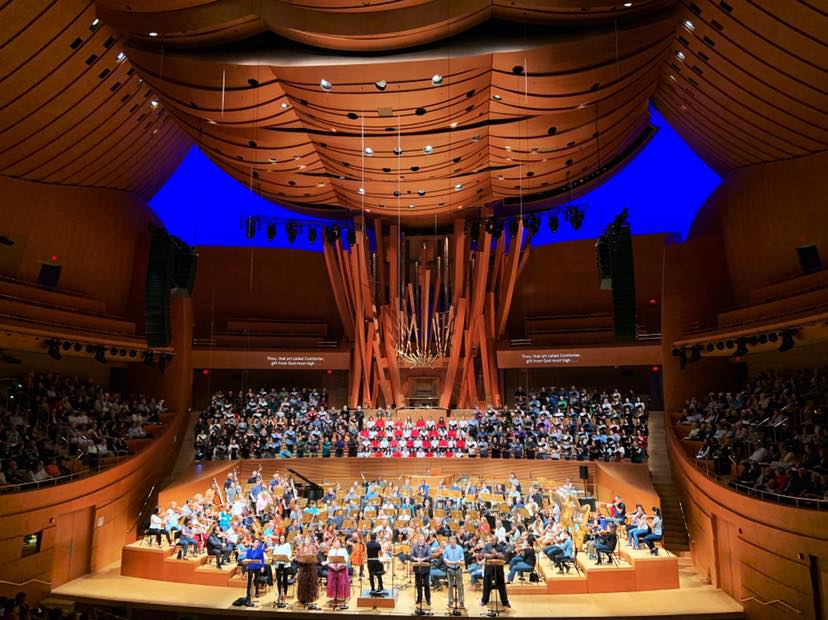AN EIGHT OUT OF TEN
About his Symphony No. 8 Gustav Mahler wrote to Dutch conductor Willem Mengelberg, known for pioneering and mastering Mahler’s works: “I have just finished my Eighth Symphony — the most magnificent of anything I have yet written. The work is so unique in terms of content and form that it is impossible to speak of it, even in a letter. It seems as if the entire universe begins to sound and ring; it is not just human voices singing, but the planets rotating and the sun…”
Normally, any composer speaking of his own work like this would be called immodest, but Mahler is right on the mark. Even though a first-timer may find the scoring so dense that they can’t follow the musical argument, no one can deny the work’s power, stinging exquisiteness, and immensity. How immense? Try an enlarged symphony orchestra (including a mandolin, celesta, and harmonium) with soloists, an organ, two mixed choruses, a boys’ chorus and vocal soloists — three sopranos, two altos, a tenor, a baritone and a bass. You’d never suspect it was rapidly composed in a tiny hut.
Gustav Mahler was everything but conformist. With the Eighth, he doesn’t just operate outside the boundaries, he creates new ones. He fashions sort of an intangible musical Elysium, a vast and titanic vision encompassing the miracle of birth and the mystery of death. Part I, Veni creator spiritus, is a song to God in praise and thankfulness for the beauty of the universe; Part II is the Final Scene from Goethe’s Faust. (The Faust connection will be positively mystifying to those who don’t know the back story. Sadly, the Olde English supertitles at Disney Hall were practically incomprehensible and no help whatsoever; avoid looking at them, if possible.)
In eighty-three minutes and two movements, this “Symphony of a Thousand” (not Mahler’s subtitle but a PR moniker created for the world premiere) demands to be seen live. Now, you only have two more chances this weekend to grasp the grandiosity of Gustavo Dudamel leading the LA Phil, the Los Angeles Master Chorale, Pacific Chorale, Los Angeles Children’s Chorus, National Children’s Chorus, and even a soprano in a sparkling gold gown appearing in the organ loft. Witnessing the Eighth live is an event so significant that it’s on many a bucket list. Last night’s opening validated why this is so.
I promise you’ll be blown away by the size, sublimity, cinematic Sensurround and sheer spectacle of it all; what may not blow you away is the sound dynamics, an even thornier issue given that this is being recorded for future release, even though Dudamel and the LA Phil — with the Simon Bolivar Orchestra — recorded another live version in 2012. (And by the way, I know the directions are difficult, Mr. and Mrs. Patron, but when you are asked to hold your applause until the end of the program, please do so. Sheesh.)
There are many times you will indeed imagine the whole universe starting to thunder and resonate (that opening!), as chorus members and brass played from the audience lofts as well, but the balance was a bit muddy when all performers were involved. All of this talent took up a gargantuan amount of space, and the choruses, acoustic instruments, and unmiked soloists all had their own idiosyncrasies of auditory range. Keeping everything perceptible and in balance was a challenge that wasn’t always met, especially when the soloists were involved.
For top-name sound, we needed top-name soloists — or, at least, a perfectly matched set of vocal soloists. Here, only one of the eight truly delivered throughout her range: American soprano Tamara Wilson. Simon O’Neill faltered in some passages, but eventually warmed up to deliver a heldentenor’s resounding top notes. Bass Morris Robinson, who was a bit fidgety on stage, simply didn’t cut it. Others who I have loved before — baritone Ryan McKinny, mezzo Tamara Mumford — simply seemed to lack force even while they sounded achingly beautiful. Leah Crocetto, Erin Morley, and Mihoko Fujimura were not powerful enough even to make an impression, so they were lost in the proceedings.
Knowing of his fragile heart condition, Mahler composed the Eighth quickly without his usual specific markings. Thus, Dudamel’s interpretation went considerably beyond what Mahler wrote, particularly in the massive adagios that are not marked in the score. He also emphasized the bellowing structure and the ecstatic apexes so powerfully that it reminded me of that ad for Memorex which had articles flying about the room next to a speaker (although we could have used even more from organist Weicheng Zhao). Perhaps more rehearsal time was needed, but Dudamel just didn’t find those little nuggets of gold as he usually does. Still, there was full-bodied choral singing to die for – the children being particularly splendid Angel Choirs – and the orchestral ensemble solos were divine: Martin Chalifour, violin; Teng Li, viola; Thomas Hooten, trumpet; and that gorgeous harp of Lou Anne Neill. Throughout his Symphonies, Mahler’s horn parts are unmatched in range and difficulty: Andrew Bain and his section were triumphant.
While this wasn’t a definitive performance (hey, it could still happen later in the weekend), this once-in-a-lifetime experience had the audience rightfully enthralled.
photos courtesy of LA Phil
Mahler: Symphony No. 8
Los Angeles Philharmonic
Gustavo Dudamel, conductor
Walt Disney Concert Hall, 111 S. Grand Ave.
ends on June 2, 2019
for tickets, call 323.850.2000 or visit LA Phil



{ 1 comment… read it below or add one }
Will there be a cd of these performances coming out from DG or another source? I attended two of the three performances and they blew me away.